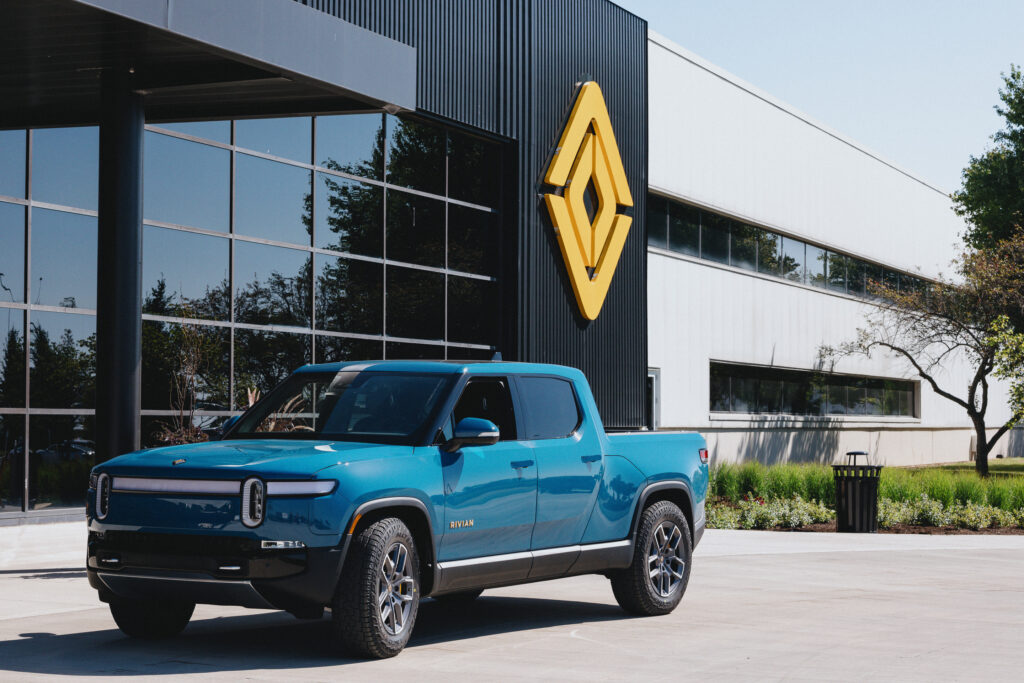[ad_1]
The little electric vehicle maker still has a lot to prove.
Rivian Automotive (RIVN -2.70%), a producer of electric pickups, SUVs, and delivery vans, went public just over three years ago. It soared from its IPO price of $78 to $106.75 on its first trade before setting a record high of $172.01 just a week later.
But today, Rivian trades at about $15. Like many other EV makers, it lost its luster as it grappled with supply chain issues, struggled to meet its own production goals, and racked up steep losses. Will it bounce back again over the next three years?

Image source: Rivian.
What happened to Rivian over the past three years?
Rivian initially attracted a lot of attention because it was backed by Amazon and Ford Motor Company. It produces three types of EVs: the R1T pickup truck, the R1S SUV, and delivery vans for Amazon. It originally planned to co-develop an electric pickup with Ford, but those plans were scrapped in late 2021.
Before going public, Rivian claimed it could produce 50,000 vehicles in 2022. However, it only produced 24,337 vehicles and delivered 20,332 for the full year. It blamed that big miss on its supply chain constraints, macroeconomic challenges, and competitive headwinds. That disappointing slowdown drove Ford to liquidate most of its stake in 2022.
In 2023, Rivian resolved its supply chain issues and ramped up its production of its in-house Enduro drive unit to cut costs. As a result, it produced 57,232 vehicles and delivered 50,122 for the full year.
But for 2024, it only expects to produce 47,000-49,000 vehicles and deliver 50,500-52,000. That slowdown was caused by a temporary shutdown of its main plant in Illinois for some major upgrades in April, new supply chain challenges, tougher competition, and high interest rates. Analysts expect its revenue to rise just 5% this year, compared to its 167% growth in 2023 and 2,915% growth in 2022.
What will happen to Rivian over the next three years?
Rivian’s slowdown in 2024 is disappointing, but its growth could accelerate over the next three years. It plans to launch its cheaper R2 SUV in 2026 and its higher-end R3 and R3X SUVs in 2026 and 2027, and continue fulfilling Amazon’s long-term order for 100,000 electric delivery vans through 2030. It also plans to sell those vans to additional customers.
Volkswagen (VWAP.Y 1.93%) also launched a new joint venture with Rivian this June to co-develop new EV architecture and software. As part of that deal, Volkswagen intends to invest up to $5 billion in Rivian and the JV over the next two years. That cash infusion should grant the company more time to ramp up its production and scale up its business.
To support that expansion, Rivian plans to construct a new $5 billion plant in Georgia, which could triple its annual production capacity. It plans to break ground on that plant by mid-2026, start up the facility in 2027, and have it reach its full capacity by 2028.
Rivian originally aimed to break ground on the plant this year, but it postponed that plan to focus on the rollout of the R2. However, it recently received a $6.6 billion conditional loan from the U.S. Department of Energy to resume its construction. If Rivian sticks to that schedule, it should start mass-producing its R2 and R3 models in Georgia by 2028.
Analysts expect Rivian to stay deeply unprofitable for the foreseeable future. But it expects its gross margin to turn positive by the fourth quarter of 2024 as it streamlines its production and installs its Enduro drive unit in more vehicles. It’s also been pruning its workforce, reducing its other expenses, and claims it has enough cash to ramp up its production.
Assuming Rivian sticks to its long-term roadmap, analysts expect its revenue to rise at a compound annual growth rate (CAGR) of 21% from 2023 to 2026. That’s a robust growth rate for a stock that trades at just 3 times this year’s sales.
Tesla, which is bigger and more profitable, trades at 13 times this year’s sales. So if Rivian matches Wall Street’s expectations, grows its revenue by another 20% in 2027, and trades at a reasonable 5 times sales, its stock could potentially soar nearly 260% and boost its market cap to about $47.5 billion by 2027.
Is Rivian worth buying right now?
Rivian is a highly speculative stock, but it also has a low valuation, a clear roadmap for the future, and adequate support and liquidity for its near-term plans. Amazon also hasn’t sold its stake in Rivian, even after Ford headed for the exits. Therefore, I believe Rivian’s stock is still worth buying if you can tune out all the near-term noise over the next three years.
John Mackey, former CEO of Whole Foods Market, an Amazon subsidiary, is a member of The Motley Fool’s board of directors. Leo Sun has positions in Amazon. The Motley Fool has positions in and recommends Amazon and Tesla. The Motley Fool recommends Volkswagen Ag. The Motley Fool has a disclosure policy.
[ad_2]
Source link

